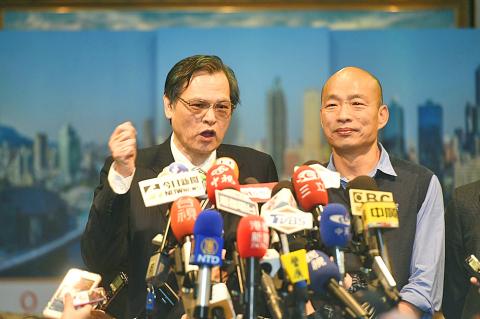Mainland Affairs Council (MAC) Minister Chen Ming-tong (陳明通) yesterday sought the “strategic support” of Kaohsiung Mayor Han Kuo-yu (韓國瑜) in their first public meeting, saying that the distance between Taiwan’s two main political parties should be narrower than that between the Chinese Nationalist Party (KMT) and the Chinese Communist Party (CCP).
The closely watched meeting was held openly in Kaohsiung and lasted about 30 minutes, during which the two officials exchanged their views on cross-strait exchanges.
Chen opened by saying that Beijing’s ultimate goal has always been to annex Taiwan, one of the three “historic missions” for the CCP and its government.

Photo: Chang Chung-i, Taipei Times
“This view is line with one of the two ‘do not doubts’ put forth by Han,” Chen said, referring to Han’s remarks on Jan. 3 that people should not doubt the CCP’s determination to annex Taiwan, nor should they doubt the will of Taiwanese to pursue freedom and democracy.
As Chinese President Xi Jinping (習近平) has laid down plans for unification and put his proposal of adopting a Taiwan version of the “one country, two systems” model on the table, Chen said that he hoped to gain Han’s support and start a strategic dialogue with him.
He produced a copy of Han’s master’s thesis on Beijing’s “united front” tactics that was published in 1988, in an apparent move to remind the mayor that he was once concerned that “the Republic of China [ROC] government has been strenuously fighting for its survival and development under threats of suppression [by the CCP] over the past 40 years.”
“Although Han and I belong to different political camps, we both possess ROC national identification cards. Like I once said, the distance between the pan-blue and pan-green camps, however wide it is, is narrower than that between the pan-blue camp and the ‘red camp’ [CCP],” Chen said.
Han said that as a mayor determined to bring economic prosperity to his city, he would not accept any rigid restrictions Chen might impose on his government, adding that the future Kaohsiung “will only have roads, not walls.”
“What you have in mind are rigid restrictions, while what I have in mind is economic development,” Han said.
“Rest assured, my city will not touch anything related to diplomacy or national defense. Kaohsiung will only be an ‘economic animal,’” he said, urging the council to be a “facilitator” of cross-strait exchanges instead of an “administrator.”
However, Han told Chen that China’s market would not be his sole target, saying that he planned to sign contracts with Malaysia and Singapore after the Lunar New Year holiday to sell Kaohsiung’s agricultural and aquatic products.
Despite brief, heated exchanges, the meeting ended on a conciliatory note after Chen reminded Han to be on the lookout for China’s unification agenda when engaging with it economically, but agreed to help relax restrictions where appropriate.
Throughout the meeting, they did not talk about the so-called “1992 consensus” — a term, former council chairman Su Chi (蘇起) in 2006 admitted making up in 2000, that refers to a tacit understanding between the KMT and the CCP that both sides of the Taiwan Strait acknowledge there is “one China,” with each side having its own interpretation of what “China” means.
Han has said that he would seek closer economic exchanges with Beijing based on the “1992 consensus,” while President Tsai Ing-wen’s (蔡英文) administration has never endorsed it, because it believes the “1992 consensus” means different things for the KMT and the CCP.

An essay competition jointly organized by a local writing society and a publisher affiliated with the Chinese Communist Party (CCP) might have contravened the Act Governing Relations Between the People of the Taiwan Area and the Mainland Area (臺灣地區與大陸地區人民關係條例), the Mainland Affairs Council (MAC) said on Thursday. “In this case, the partner organization is clearly an agency under the CCP’s Fujian Provincial Committee,” MAC Deputy Minister and spokesperson Liang Wen-chieh (梁文傑) said at a news briefing in Taipei. “It also involves bringing Taiwanese students to China with all-expenses-paid arrangements to attend award ceremonies and camps,” Liang said. Those two “characteristics” are typically sufficient

A magnitude 5.9 earthquake that struck about 33km off the coast of Hualien City was the "main shock" in a series of quakes in the area, with aftershocks expected over the next three days, the Central Weather Administration (CWA) said yesterday. Prior to the magnitude 5.9 quake shaking most of Taiwan at 6:53pm yesterday, six other earthquakes stronger than a magnitude of 4, starting with a magnitude 5.5 quake at 6:09pm, occurred in the area. CWA Seismological Center Director Wu Chien-fu (吳健富) confirmed that the quakes were all part of the same series and that the magnitude 5.5 temblor was

The brilliant blue waters, thick foliage and bucolic atmosphere on this seemingly idyllic archipelago deep in the Pacific Ocean belie the key role it now plays in a titanic geopolitical struggle. Palau is again on the front line as China, and the US and its allies prepare their forces in an intensifying contest for control over the Asia-Pacific region. The democratic nation of just 17,000 people hosts US-controlled airstrips and soon-to-be-completed radar installations that the US military describes as “critical” to monitoring vast swathes of water and airspace. It is also a key piece of the second island chain, a string of

The Central Weather Administration has issued a heat alert for southeastern Taiwan, warning of temperatures as high as 36°C today, while alerting some coastal areas of strong winds later in the day. Kaohsiung’s Neimen District (內門) and Pingtung County’s Neipu Township (內埔) are under an orange heat alert, which warns of temperatures as high as 36°C for three consecutive days, the CWA said, citing southwest winds. The heat would also extend to Tainan’s Nansi (楠西) and Yujing (玉井) districts, as well as Pingtung’s Gaoshu (高樹), Yanpu (鹽埔) and Majia (瑪家) townships, it said, forecasting highs of up to 36°C in those areas